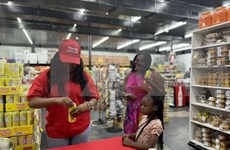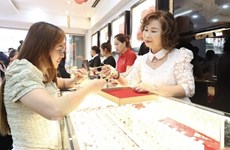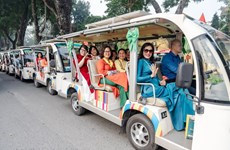Can Tho hosts talks on pangasius farming
Producers, conservationists, government officials and experts joined a meeting
in Can Tho city on March 4 to present and discuss feedback on standards for
pangasius (tra and basa fish) farming.
Producers, conservationists, government officials and experts joined a meeting
in Can Tho city on March 4 to present and discuss feedback on standards for
pangasius (tra and basa fish) farming.
The two-day discussion is the final meeting of the Pangasius Aquaculture Dialogue (PAD), which was first launched by the World Wide Fund for Nature (WWF) in 2007.
“There is a huge demand for farmed pangasius in the market place, but what is missing on the market is a credible label for environmentally-friendly pangasius,” said Flavio Corsin, a WWF coordinator.
Corsin said pangasius farming is one of the fastest growing forms of aquaculture and 90 percent of the farming activities are conducted in Vietnam , especially in the Mekong River delta.
The explosion of pangasius farming poses challenges to not only in aquaculture practices but also to consumer health and the environment.
Scores of participants agreed that in order for pangasius farming to develop sustainably, producers need to build a standardised fish farm, which must be located within a planned aquaculture area. Sewage water from the farm must be discharged properly so as not to affect other producers. The location of the farm must not hamper waterway transport and the movement of marine creatures.
The necessity for each farm to have a minimum of 5,000 cu.m of water per tonne of fish was also raised as one of many other requirements.
The final standards are expected to be drawn up this May.
Since its inception, the PAD has become a forum to field opinions from pangasius farmers in Vietnam and Bangladesh regarding farming standards so as to ensure effective and environmentally-friendly pangasius production./.
The two-day discussion is the final meeting of the Pangasius Aquaculture Dialogue (PAD), which was first launched by the World Wide Fund for Nature (WWF) in 2007.
“There is a huge demand for farmed pangasius in the market place, but what is missing on the market is a credible label for environmentally-friendly pangasius,” said Flavio Corsin, a WWF coordinator.
Corsin said pangasius farming is one of the fastest growing forms of aquaculture and 90 percent of the farming activities are conducted in Vietnam , especially in the Mekong River delta.
The explosion of pangasius farming poses challenges to not only in aquaculture practices but also to consumer health and the environment.
Scores of participants agreed that in order for pangasius farming to develop sustainably, producers need to build a standardised fish farm, which must be located within a planned aquaculture area. Sewage water from the farm must be discharged properly so as not to affect other producers. The location of the farm must not hamper waterway transport and the movement of marine creatures.
The necessity for each farm to have a minimum of 5,000 cu.m of water per tonne of fish was also raised as one of many other requirements.
The final standards are expected to be drawn up this May.
Since its inception, the PAD has become a forum to field opinions from pangasius farmers in Vietnam and Bangladesh regarding farming standards so as to ensure effective and environmentally-friendly pangasius production./.












